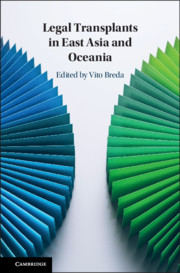Book contents
- Legal Transplants in East Asia and Oceania
- Legal Transplants in East Asia and Oceania
- Copyright page
- Dedication
- Contents
- Figures
- Tables
- Contributors
- Acknowledgements
- Table of Cases
- Table of Statutes
- Abbreviations
- Introduction
- Part I
- Part II
- 5 The Incomplete Legal Transplant – Good Faith and the Common Law
- 6 How Long Is Too Long to Determine the Success of a Legal Transplant? International Doctrines and Contract Law in Oceania
- 7 Proportionality in Australian Public Law
- 8 Legal Transfer and ‘Hybrid’ International Commercial Dispute Resolution Procedures: Lessons from the Singapore International Commercial Court
- 9 The Independent Lawyers’ Association of Myanmar as a Legal Transplant: Local Challenges to the Idea of an Independent National Bar Association
- Part III
- Index
- References
8 - Legal Transfer and ‘Hybrid’ International Commercial Dispute Resolution Procedures: Lessons from the Singapore International Commercial Court
from Part II
Published online by Cambridge University Press: 18 June 2019
- Legal Transplants in East Asia and Oceania
- Legal Transplants in East Asia and Oceania
- Copyright page
- Dedication
- Contents
- Figures
- Tables
- Contributors
- Acknowledgements
- Table of Cases
- Table of Statutes
- Abbreviations
- Introduction
- Part I
- Part II
- 5 The Incomplete Legal Transplant – Good Faith and the Common Law
- 6 How Long Is Too Long to Determine the Success of a Legal Transplant? International Doctrines and Contract Law in Oceania
- 7 Proportionality in Australian Public Law
- 8 Legal Transfer and ‘Hybrid’ International Commercial Dispute Resolution Procedures: Lessons from the Singapore International Commercial Court
- 9 The Independent Lawyers’ Association of Myanmar as a Legal Transplant: Local Challenges to the Idea of an Independent National Bar Association
- Part III
- Index
- References
Summary
The recent genesis of international commercial courts has given rise to a new conception of ‘hybridized’ dispute resolution procedures, crafted by a liberal drawing from perceived global best practice across both international commercial arbitration and litigation. As these courts depend upon an exclusive choice of forum to support their jurisdiction, the hybridity reflected in these procedures is intended to represent an attractive balance between the flexibility inherent in arbitration, and the greater degree of judicial compulsion and guidance seen in traditional national courts. This form of hybridity is perhaps best represented by the genesis of the Singapore International Commercial Court (‘SICC’), driven by the perceived dominance of arbitration in transnational dispute resolution, as well as the sheer growth of transnational trade both globally and regionally in East Asia (and the resulting need for greater transnational dispute resolution services).
- Type
- Chapter
- Information
- Legal Transplants in East Asia and Oceania , pp. 183 - 210Publisher: Cambridge University PressPrint publication year: 2019
References
V Bibliography
- 1
- Cited by

